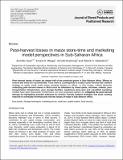Post-harvest losses in maize store-time and marketing model perspectives in Sub-Saharan Africa
| dc.contributor.author | Swai, Jennifer | |
| dc.contributor.author | Mbega, Ernest | |
| dc.contributor.author | Mushongi, Arnold | |
| dc.contributor.author | Ndakidemi, Patrick | |
| dc.date.accessioned | 2023-09-07T13:01:42Z | |
| dc.date.available | 2023-09-07T13:01:42Z | |
| dc.date.issued | 2019-01-31 | |
| dc.identifier.uri | https://doi.org/10.5897/JSPPR2018.0270 | |
| dc.identifier.uri | https://dspace.nm-aist.ac.tz/handle/20.500.12479/1915 | |
| dc.description | This research article was published by Academic Journals in 2019 | en_US |
| dc.description.abstract | Post‒harvest losses of maize are almost half of the produced grains in Sub‒Saharan Africa. Efforts to reverse this trend are recommended. Thus, there is a prerequisite to create a post‒harvest loss resilient strategy to guide small scale maize growing farmers in Africa. In this review, critical elements underlying post‒harvest losses in Africa such as infestation by insect‒pests, microbes, rodents, poor transportation infrastructure, poor storage facilities, injudicious store‒time and unjustified marketing models have been discussed. Furthermore, we have proposed options for mitigating the post‒harvest damage by highlighting possible pathways for farmers’ friendly resilient strategies and areas needing research to eventually minimize post‒harvest losses of maize in Sub Saharan Africa | en_US |
| dc.language.iso | en | en_US |
| dc.publisher | Academic Journals | en_US |
| dc.subject | Storage techniques | en_US |
| dc.subject | Marketing prices | en_US |
| dc.subject | Spatial market | en_US |
| dc.subject | Food security. | en_US |
| dc.title | Post-harvest losses in maize store-time and marketing model perspectives in Sub-Saharan Africa | en_US |
| dc.type | Article | en_US |

